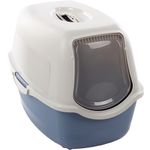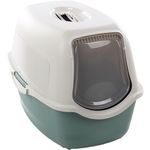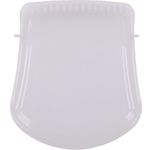By rabbit behaviour therapist Stien - Kontent Rabbit
Practical tips from rabbit behaviour therapist Stien
Litter training. Perhaps not the most glamorous topic to discuss, but one that every rabbit owner has to deal with. Because as cute as rabbits are, their droppings all over the living room are not so cute.
Fortunately, there is good news: rabbits can be litter trained! And quite often, they’re already halfway there by nature. Sometimes they just need a little push from you.
Rabbits are quite tidy by nature
Rabbits are actually quite tidy by nature. In the wild, they use a specific spot to do their business, usually deep inside their burrow. Not because they’re neat, but because it’s clever to keep their scent in one place. You can make great use of that natural habit when training your pet rabbit. It all comes down to timing, the right spot, and—most importantly: a litter tray that makes sense to your rabbit.

Choosing the right bedding
Not all bedding is suitable for a rabbit litter tray. So you need to be careful when choosing bedding. Avoid clay-based cat litter. If ingested, it can clump in the stomach and cause serious blockages. Opt for wood or straw-based pellets instead. These are safe, absorbent, and control odours effectively.
“I personally use Flamingo brown wood pellets. They’re natural, dust-free, and highly absorbent – perfect for rabbit litter trays. Spread a two to three cm layer in the tray. This keeps it clean, makes it comfortable for your rabbit, and allows you to change it easily every day."
Hay is part of the process
Many people don’t realise this, but rabbits prefer to do their business while eating. It might sound a bit odd, but it’s completely natural behaviour. You can use this instinct to your advantage by placing a hay rack or a handful of hay above or next to the litter tray.
A great choice is the Flamingo Snack Meadow Hay. It smells wonderfully fresh, comes from natural meadows, and is rich in fibre. Fibre isn’t just great for digestion, it also helps keep your rabbit’s ever-growing teeth in good condition.
By placing hay near the litter tray, you make that spot more inviting and increase the chances that your rabbit will use it consistently.
Where to place the litter tray?
Observe your rabbit’s behaviour closely. Where does it already tend to urinate? Often, this will be in a corner of its enclosure or at a specific spot in the living area. Place the litter tray there and keep an eye on it.
If your rabbit urinates elsewhere, clean the area thoroughly with a mixture of water and vinegar to remove the scent, and consider moving the tray to that spot. Essentially, your rabbit’s behaviour indicates what feels logical to it, and the more you go along with its cues, the quicker it will understand.


















